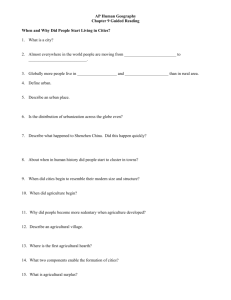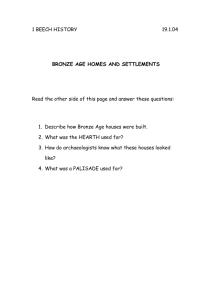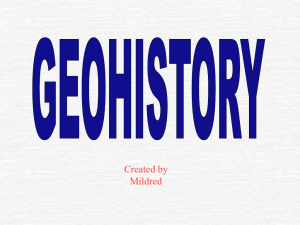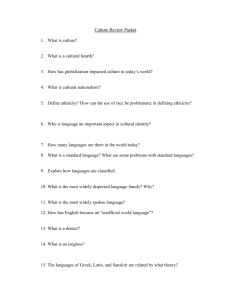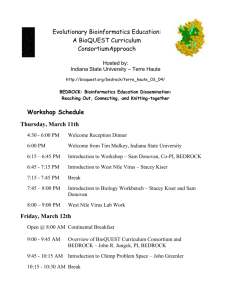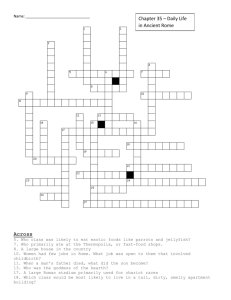Kendall Ch05SR
advertisement
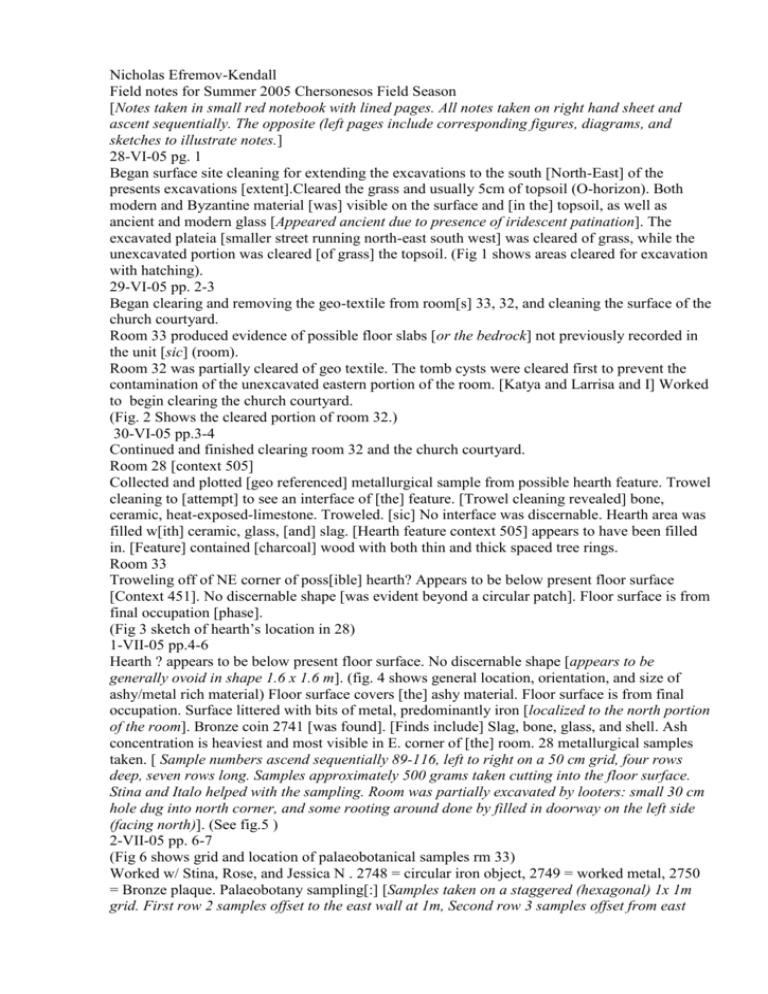
Nicholas Efremov-Kendall
Field notes for Summer 2005 Chersonesos Field Season
[Notes taken in small red notebook with lined pages. All notes taken on right hand sheet and
ascent sequentially. The opposite (left pages include corresponding figures, diagrams, and
sketches to illustrate notes.]
28-VI-05 pg. 1
Began surface site cleaning for extending the excavations to the south [North-East] of the
presents excavations [extent].Cleared the grass and usually 5cm of topsoil (O-horizon). Both
modern and Byzantine material [was] visible on the surface and [in the] topsoil, as well as
ancient and modern glass [Appeared ancient due to presence of iridescent patination]. The
excavated plateia [smaller street running north-east south west] was cleared of grass, while the
unexcavated portion was cleared [of grass] the topsoil. (Fig 1 shows areas cleared for excavation
with hatching).
29-VI-05 pp. 2-3
Began clearing and removing the geo-textile from room[s] 33, 32, and cleaning the surface of the
church courtyard.
Room 33 produced evidence of possible floor slabs [or the bedrock] not previously recorded in
the unit [sic] (room).
Room 32 was partially cleared of geo textile. The tomb cysts were cleared first to prevent the
contamination of the unexcavated eastern portion of the room. [Katya and Larrisa and I] Worked
to begin clearing the church courtyard.
(Fig. 2 Shows the cleared portion of room 32.)
30-VI-05 pp.3-4
Continued and finished clearing room 32 and the church courtyard.
Room 28 [context 505]
Collected and plotted [geo referenced] metallurgical sample from possible hearth feature. Trowel
cleaning to [attempt] to see an interface of [the] feature. [Trowel cleaning revealed] bone,
ceramic, heat-exposed-limestone. Troweled. [sic] No interface was discernable. Hearth area was
filled w[ith] ceramic, glass, [and] slag. [Hearth feature context 505] appears to have been filled
in. [Feature] contained [charcoal] wood with both thin and thick spaced tree rings.
Room 33
Troweling off of NE corner of poss[ible] hearth? Appears to be below present floor surface
[Context 451]. No discernable shape [was evident beyond a circular patch]. Floor surface is from
final occupation [phase].
(Fig 3 sketch of hearth’s location in 28)
1-VII-05 pp.4-6
Hearth ? appears to be below present floor surface. No discernable shape [appears to be
generally ovoid in shape 1.6 x 1.6 m]. (fig. 4 shows general location, orientation, and size of
ashy/metal rich material) Floor surface covers [the] ashy material. Floor surface is from final
occupation. Surface littered with bits of metal, predominantly iron [localized to the north portion
of the room]. Bronze coin 2741 [was found]. [Finds include] Slag, bone, glass, and shell. Ash
concentration is heaviest and most visible in E. corner of [the] room. 28 metallurgical samples
taken. [ Sample numbers ascend sequentially 89-116, left to right on a 50 cm grid, four rows
deep, seven rows long. Samples approximately 500 grams taken cutting into the floor surface.
Stina and Italo helped with the sampling. Room was partially excavated by looters: small 30 cm
hole dug into north corner, and some rooting around done by filled in doorway on the left side
(facing north)]. (See fig.5 )
2-VII-05 pp. 6-7
(Fig 6 shows grid and location of palaeobotanical samples rm 33)
Worked w/ Stina, Rose, and Jessica N . 2748 = circular iron object, 2749 = worked metal, 2750
= Bronze plaque. Palaeobotany sampling[:] [Samples taken on a staggered (hexagonal) 1x 1m
grid. First row 2 samples offset to the east wall at 1m, Second row 3 samples offset from east
wall at 0.5m] 117 1.m, 1.m [;] 118 1.m, 2.m 119 2.m, .64m [from W wall]. Sample grid at 1 m,
w alternating lines. (See fig. 6). Hard packed surface probably baked in destruction fire [and due
to exposure to the sun]. Found small bit of copper, discarded [bit was too small to be diagnostic
of either slag or special find]. 2752 copper-alloy strip (two pieces). Nails [mapped]. Geo-ref’ed
all samples 117-121. Collected shell, bone, slag, [illegible glob clams], nails.
(Fig 7 shows grid and location of palaebotanical samples rm33)
4-VII-05 pp. 8-9
(Fig 8 shows grid and location of palaebotanical samples rm33)
Worked w/ Olga, Stina, Roze, and Jessica N peeling the floor from appx the mid-point. Found
2757 Bronze coin. High densities of bone across the floor. Floor peels off to [ another] hard
packed surface with protruding bedrock in some areas. 27 59 copper alloy plaque, 2760 Iron
object, 2765 Iron object. 1 full tile bucket. [Samples 188-190 taken on the hexagonal grid offset
.5m from east wall on 1m grid]. Almost finished room, 1-1.5 m left. Still [finding] nails,
ceramic[s], and pottery. * Total station pole was off by 6 cm form some unknown shots.
Presumably samples, and at least 1 find. [South portion of the room has a noticeably higher bone
density]
5-VII-05 pp. 9-12
(Fig 8 shows sketch of 33’s features)
Room 33
Worked to finish room [with Olga and Rose]. Samples taken [final row 191-192] not on full 1m
grid [taken at] (80cm) [to accommodate for the South wall]. Worked w/ Gordana, Olga, [and]
Jessica N. Found 2768 TC [terracotta] spindle whorl and 2771 bronze coin. [Encountered patch
of industrial debris. Deposit’s structural integrity was compromised by zealous excavation. The
deposit yielded:] Ceramic slag (attached), slag, ashy soil, heat exposed pottery/tile. Patch of soil
7.5YR 3/2. [Observed clay bonded w[ith] stones 2m from S[outh] wall 50 cm from SW sic
[actually east wall. Patch appears to be melted mud-brick, lying on top of a possible earlier
wall.] Took metal sample [from possible hearth feature]. Possible hearth feature ID’d sic by CS
[Chris Salter]. (See fig 10 for location of 518) Heavy slag density [observed] w[ith] possible
hearth bottom. Baked floor [surface of 451] covering a charcoal layer above one w[ith] metal
working debris. Hearth feature has no discrete features. Heavily ashy soil 10YR 2/2 w[ith] floral
turbation [Roots from exposure under geo-textile]
(See fig 11 for location of 518)
6-VII-05 pp.12-15
Worked w[ith] Olga. Feature, hearth needs context number. 260 Metallurgical sample [taken
from hearth feature]. Must map [sample] 238. New context [assigned to hearth feature] 518.
Worked into the doorway. Found a coin, bronze, and a metal bracket. Doorway filled with rock
and ultra compact deposit sic [read sediments] containing glass, bone, shell, ceramic, and tile.
Iron object [was] pulled from the doorway. [Context] 451 revealed discrete surface change
defined by a looser, [more yellow] soil (per A[T]R) and sherds with a horizontal orientation. Ash
patches were mapped by Alison. Surface appears to be an agglomeration of use debris and
intentional fill for leveling. Noted water worn pebbles packed into the doorway [waterworn
pebbles noted as a part of the ultra-compact surface. The surface was necessarily compacted as
being the highest area of traffic in the room. The doorway, was surely blocked at the time of
451’s existence as the final floor, allowing for the door in the south to be the only point of entry
to the room.] Metallurgical samples will be taken from 33, 32, and 28. [Room] 33 [sample] grid
in N. half, 1 sample from doorway. [Room] 28 sample 505 from hearth feature. [Room] 1 line in
the south [actually Northern] portion, and 2 lines in the North [actually south] portion. [Context]
519 28 samples taken. [Context] 354 [room] 32 [nine samples] taken. Sea grass [noted and
originally thought to be from floral- turbation] roots [later told that the sea grass was used as packing
material for the roofing material. Found in conjuction with scattered tiles, not sampled per ATR who said
the grass had been identified previously at the site]. Jessica [Nolan] mapped [the samples] in room 32.
Took all samples on 50 x 50 cm grid, except 290-292 which were equidistantly placed, with the
exeception of sample 292 which was placed to accommodated. Samples taken were [appx.] except when
the soil wasn’t available for sampling [when a representative sample was taken]. Possible mapping error
[may have] occurred [at] sample 267 [GIS data was consulted and grid was intact with no mapping
errors]
7-VII-2005 pg.16
Excavated hearth feature in room 28 [context] 505. [Hearth largely excavated afternoon 6-VII-05 with
Larissa N’s help and finished on 7-VII-05 to map finds. Fill appeared the same as some of the
surrounding floor, as the product of a single leveling event. The ash from the feature spilled out and
around the hearth features itself, as such portions of the surrounding floor surface were considered part
of the same context]. Found [bronze] coin 2791. Hearth feature was densely packed with tile [lain/laying
flat], ceramic, coin [1], nails, and a lot of bone. It seemed to be obvious fill with shells and sherds
[encounterd] on edge, the tile lay flat, possibly a sign of intentional packing [as part of the leveling
episode].
{Room 32}
Sherds observed on edge [pieces of tile from context 461 visibly seen on edge and protruding below the
surface of 354, out of contect 461] The soil is compact and yellowish w[with] white [flecks] mottling.
8-VII-2005 pp. 17-18
Mapped samples 299, 300 paleobotanical. [Intention is to] removed context 460 (grey ashy material) [and
to move into context] 461 (brown fill). Removed large flat rock [which was given context number] 529. It
sat on 10 YR 4/2 fine silt-loam w[ith] sea grass below it [this material is the same as 354]. Palaeobotany
sample (314) taken [and] treated as context 354 [rock sat on the floor surface above 461, and was not
removed from the room with 354’s removal. All the soil below the rock was placed in a PB sample and
mapped for expedient removal]. 2807 game piece [bone] on surface [horizontal]. Took additional
metallurgical samples from both soil [ashy] patches [for Chris Salter to look at and determine likelihood
of metallurgical activity associated with ash features.]
9-VII-2005 pp. 18-21
460, 531
Excavated ash filled depression [cut 631 50 x 50 cm circular depression appx 10-15 cm deep] which
contained, metallurgical debris, bone, ceramic, and tile. Soil was semi-compact and mottled with little
white blotches. The ash-pit [cuts 633, 634] contained 10YR 2/1 black silt-loam, w[ith] bits of coal. Two
nails were found in the pit, and some bits of cuperous slag.
Context 461
[461] Is a hard, compact silt-loam w[ith] flecks of white and some pieces of ash. Will take paleo-bot sic
samples every 25 cm down.
Found two circular depressions in the bedrock, # 2 filled w[ith] context 354. [Depressions] 1,3, [4] [cuts
631, 633, and 634] were filled with material all called 460. Depression 2, 3 [4] are modified [read:cut]
bedrock. Depression 3 [and 4] continues below wall (E.) Found bedrock [bottom] in depression 2. Rose
big-picked S. regious of 461. Depression 3 contained many small pieces of carbonized wood. Pit 3
[depressions3-4] has a rock structure [it was unclear if the structure was a construction. It was built,
highly irregularly, and did not fully separate the two depressions, cuts 633, and 634. However it is hard
to believe, even if the structure is crudely built, that stones would fall into a pit in a wall like orientation.
In retrospect it is the excavator’s opinion that the rocks were probably a structure of unknown purpose.]
[Context] 540 assigned to ash patch [in south region of room 32, it is possible that this ash patch is
associated with 460 above it, as such the material was isolated for stratigraphic control]. Patch may be
part of 460, was difficult to discern a strat[igraphic] break.
11-VII-2005 pp. 21-23
Took three spot heights on 540, and 4 for 461 north. Finished context 460.
Intact vessel found in 461 (largely). Will work into 461 in the N[orth]. [We will work in from the
excavated portion, leaving a small micro-baulk to prevent spilling]. Took sample 329 @ PB floor surface
[palaeobotanical sample taken at floor surface]
540 Cluster of nails found in N[orth] corner of the pit. Pit goes down to bedrock. Began taking N[orth]
421 sic [actually 461]. Very compact medium brown silt-loam. Obviously fill. Sherds, bone, and glass
found at various orientations [indicative of fill nature:duh!] Fill was compact and almost concrete like
near depression 1 [631] [this is probably hardening due to baking] Found small bronze coin in E. Corner.
Closed context 460.
Vessel was broken w[est] of 461. Vessel was broken on a newly identified floor surface, not intact.
[Vessel was probably not intact prior to deposition in the fill]
12-VII-2005 pp. 23-25
Rose worked in the ash-pit, found bedrock. Worked in north portion continuing to bedrock. 2858-Bone
game piece.2863 Bronze nail-head/coin 2880-coin (roman?). Worked in North portion of 461. Finds: high
density of amphora sherds, glass less dense but still present [upper levels of fill much higher density].
Rose worked and finished the ash pit-540. Ash pit contained, nails, ceramic, and metallurgical debris in
high density. 540 was filling 551 (assigned cut to cut of 540) and cutting 461. Bedrock appears modified
(intentionally cut) in both the south and the north. Took one palaeobotanical sample in the south just
above the bedrock. Pit 1 [long trough like cut in north portion of the room 32, context assigned during
CH04] appears to be a 60 cm wide trough, while pit 4 appears to a roughly sic cut generally rectilinear on
a north-east to south-west orientation. [Larger bedrock cut appears to be analogous to those identified in
33 and by Anton Smirnof]. All pits appear to be intentionally modified [they are], but without clear
purpose or immediate indication or evidence of function.
13-VII-2005 pp.25-29
Bedrock shape changed again, upon removal of the last sediments overlying the bedrock. In some places
the bedrock had melted, in some places the shape revealed probable cut further associated with 551 [cut
of 540]. Final removal of sediments revealed irregular bedrock. Coins agreed [upon] to potentially be
Roman, and one sherd possibly Hellenistic. Modified bedrock associated with phase of context 460/461.
Bedrock will be topo’d and planned.
[28 room] Finished planning hearth feature.
33
Floor surface context 519 [appeared different when first exposed, partially due to raining, or just clearer
thinking] appears littered w[ith] ceramic, tile, and bone, all on a horizontal orientation [closer observation
revealed a quantity of material on edge protruding through the surface of 519. Beginning w[ith] hearth
feature 508. 2896 Iron object. Traced ash patch, identified two discrete pits [hearth feature 555, is
separate from 554: fill of pithos cut in NW portion of the room]. Assigned contexts to fill and cuts. Pit
554 seen as discrete from 508, which now isolated as the ash-lens covering the feature [cont. 555].
Contexts were created for the cuts of both features, which will be mapped by Allyson. Discerned possible
leveling fill, previously identified as a lower floor surface. It appears to be a different color, and more
densely filled with anthropogenic material. The fill of the ash patch looks to be a one-time filling episode.
Second area of leveling fill, looks like a possible earlier wall, or again leveling fill. [Context 567, which
appeared to an alignment two courses wide located in the S. corner of 33.]
16-VII-05 pp 32-34
Worked with Dan, and Jess[ica] N. Decided w[ith] ATR to begin removing sediments as continuing 519.
[Sediments were to be removed in the North corner to delineat a possible interface of the fill.] We will
plan the cuts and then look for some sort of distinction. Method: peeling layer back from the N[orth]
corner attempting a discern interface sic. 572 Brown soil in the N. corner, stricken [soil difference
attributed to moisture, further exposure confirmed same consistency and finds.] Di
18-VII-2005 pp. 34-35
Room 33 Context 518
Continued working [with Dan and Jessica N.] into N[orth] corner attempting to define [the] fills limits.
Fill continues without obvious change. Minor changes in artifact and soil consistency noted. Continued
removing sediments approaching the possible wall in the N[orth] corner of [room] 33. Exposed area of
wall sized stones in an irregular scatter app[roximately] 1m from the N[orth] wall and 1.6m from the
W[est] wall. Stones [are] intermingled w[ith] plaster and tile with no discrete orientation. [Initial
assessment appeared to show an alignment of stones following the west wall and aligned with the bedrock
cut. Further articulation revealed no such orientation, but the stone scatter may infact represent an
intentionally felled wall, for fill purposes, or a weathered wall’s collapse. In either case, it appears that the
material was either used intentionally, or expediently as fill.]
19-VII-2005 pp. 35-37
Worked with Dan and Jess N. [in room 33]. Noting significantly less metallurgical debris in articulating
possible wall in the scatter of stones in the N[orth] corner of [room] 33. Dropped the N[orth] portion
lower to attempt to articulate stones and define fill limits. Stone pile appears dense and will be separated
and given a context [number]. We will leave it alone for the investigation of the fill/? Sic interface. [The
level of 519 was dropped significantly lower in an attempt to find a surface to follow across the room.
Approximately a 15 cm micro-baulk was cut, and no obvious stratigraphic break was visible, the material
south of the stones is slightly looser, and richer in cultural material; however the soil consistency, color,
and material assemblage doesn’t appear different. Context is producing high volume of bone and
ceramics, including some material identified by Gordana as 10th c. The scatter of stones was sampled for
plaster, which was found intermingled with tiles among the stones. Significantly, the tiles do not appear to
be intact or indicative of wall or roof collapse.] [Designated the floor of the hearth] 589 Bottom of 555
[which is] the floor hardened from use as [a] hearth. Removed ashy [compact] metal-debris-rich material.
Few finds [in the upper parts of the layer. The bottom layers of the hearth feature were generally oval, and
approximately 10cm below the first identified surface. The material was very ashy, and quickly turned
into another hardened surface intermingled with iron-working debris. Slag, hammer-scales, and lumps of
iron. Two bronze strips were removed from the hearth feature. The very bottom of the context produced
several sherds including one with yellow glaze].(519) Last pass became increasingly materially rich. No
obvious break in stratigraphy. [Took three paleobotanical samples, 2m from the North wall, offset from
the west wall at 0.5m. 378, 379, 380 approaching west wall. 1 Metallurgical sample was taken from the
floor of the hearth feature. 1 sample taken of the plaster found among the stones]
20-VII-2005 pp 37-38
Worked with Dan D. and Jess N. continued peeling 519 south towards the door. Changed
methods to big-pick[ing] to blast through the material. [Sediments] material is noticeably more
materially rich, produced 6 individual bags of material (sherd/bone). Identified possible by the
possible wall in the S.E. corner (567) . Significant drop in metal finds [noted]. Encountered a
large rock in the fill [center of the room], which probably lies on a surface. Finding cow, pig, and
fish bones. Took mortar sample from near possible wall [586]. [Mortar sample is actually plaster,
intermingled and noted on context sheet for context 586. Mortar noted through lower level of
519, both in ramp and especially in high concentration across the N. portion of the unit.]
21-VII-2005 pp 38-41
Worked w[ith] Dan D, Jessica N. , and Larissa N. Decided to stop tracing identified surface, and
work back into the north till we reach level . Encountering possible clayier sic surface. There’s
some question to the stone collapse’s (586) relationship with the fill. We will have Gordana
photo [the] vessel, and remove it. (10 tile buckets) continuing down onto surface with walling
stones. Surface appears discrete [read separate] from that identified in S. region. Took one
sample (425) of ??? organic material and two paleo samples 426/427 . Found a slab w[ith] [a]
hollow [cavity below it. Clearly indicative of the fill’s nature. Probably indicative of a quick
relatively careless filling.] clear sign of rushed fill. Finds still the same, moving quickly [through
the material. The nature of the deposit as fill, allows for expediency in moving through the
material.] Dan dropped a hole [following the loose fill down] into [by] the hollow material sic
[read area] by the slab [in the center of the room]. Profile revealed a 50 cm deep deposit of the
same fill.
22-VII-2005 pp. 42-43
Worked w[ith] Dan, Jessica, and Larrisa. Continued articulating toward the south. Will spot
height various features [identified in the fill area, rock pile 586, and a clay island of soil, and the
trodden earth ramp] and exo [remove them]. Alison will plan [ the features and the features will
be] photo[graphed]. Removed 586 [which revealed] same material [underlying the rocks].
Removed the soil island [area of clayier and denser material, probably the result of a dump of
clayey material during the filling of the room, likewise 586 is probably a dump of some rocks].
Indicative of fill [a] large stone was lying askew [area underneath was hollow, aforementioned].
Coming down to some level, possibly just the same fill.
23-VII-2005 pp. 43
Worked w[ith] Dan, Jessica, and Lariss[a]. Worked to take the north corner down. Will proceed
to take the ramp out next. Identified surface over bedrock in S. corner pf 33, and in N. section. In
N. section there is plaster insitu (519). Remarked as “very different” by ATR. Photographed ring
w[ith] jewel in situ. Conservation will be called in to investigate/remove possible plaster feature.
Plaster feature is moulded plaster, it will be conserved by the conservation team. Identified
surface in the N. (636). Considering both the ring and plaster as from above. Another possible
surface identified [in the south of the unit]. We will trace to see if they meet.
25-VII-2005 pp 45-49
Worked with Dan, Larrisa, and Jessica N. exposing context 636. 28 tile buckets removed from
context 519. Sketched ash patch (630) in notebook. Worked on the east side to attempt to
delineate ash patch. Assigned context 640 to compact patch in W corner of 33. Possibly the same
but isolated for control. Photo 567, will remove after relationship to the floor is established.
Possibly the material was used as packing to support wooden walls [for dark-age sunken floor
building] 3250 architectural fragment. Compact yellowish soil [encountered in the south region,
removed as part of 519. Cleaned and photo’d 567. cleaned surface of 636. Cleaned 630, shot spot
heights, removed 630.
Shot spot heights on context 640, compact surface removed. Prooved largely sterile, some
ceramic, tile, and faunal material overlying a bedrock ledge. Slightly ashier and greyer. Plaster,
which was faced was collected [from context 519]. Material appears to be concentrated to the
north part of the unit.
26-VII-2005 49-52
Identified loose ashy material 647 [Material was somewhat compact under 644, but traced into
depression of 653, soil looser to due to attempted removal of large building stone.] Material
overlay 636, 999. Had large building stone [in the] cut. 647 was overlain by 644. Assigning
context to possible wall packing feature in west corner. Checking to remove 567, and 654. Will
photo double check plans and exo [remove sediments]. ATR revealed probable bedrock shelf.
567 questioning relationship to 636, material likely to be similar to 519 [it is]. We will give
context to cut 647, 653. 630 , 644, are likely dumps with 519 [ceramic analysis suggests that this
is not the case, and they are likely associated with 636/672]. Mudbrick, 10yr 7/4 removed from
the top of 567 has a mortar/architectural sample (465). Wall (???) 567 intermingled with bits of
plaster, and voids intermingled with patches of ashy soil and 10YR 4/3. 567 produced similar
material in sic.
Removing material from doorway, possible stoop. 657 soil in doorway, 658 stoop/step into 33
(construction).
Removed 661. Leaving 654 took 5 palaeo samples, from 636. found coins in 661, 636 found
brick over bedrock in the center of 653.
27-VII-2005 pp 52-55
Assigning 672 to lower floor surface, first identified by thin patch of fine ash [which overlay the
northern half of the unit]/ Surface peels off cleaning. Materials isolated for stratigraphic control .
Found coins etc. Layer continues to the mid point of the room. Ash not consistently associated
with the strat change. Finding dark-age material [per ATR and LVS].
Wall 281 dips into a pit/cut in the bedrock, down to at least the level of 636. As such 661 is
probably a fill of that pit. The question remains as to the depth of the pit. Coins found below 661,
may be contaminated sic [contamination] by later coin due to 661’s fill nature. Found patch of
clayey material in south of the room. Possible post hole (cont. 674). Will photo lower surface
and top/
674 fill of loose brown soil. Possible post hole.
675 cut of 674.
672 almost directly over bedrock in S.E corner w, depression in the SW. Began removal of wall
collapse (298) in the plateia. Removed stones from the wall [disarticulated] Found arrow head
and took charcoal sample.
28-VII-2005 pp 55-58
Sample’s of floor 672. Both hearths have context #’s. Will paleo sample both features, and
expediently over 672 lower floor surface. Sample hole, of material removed from 636 reveals
greater depth in W southern portion of the room. Hearths are stains of [brown and ashy] material.
Organic sample (olive pip) taken from 695 [hearth 1].
Hearth 1 -695.
35 cm wide, 32 long, filled with ash patch (10YR 7/2) with flecks of ash. No cultural material in
the ash. Encountered weird plaster dealy [identified as melted bedrock-did not deposit itself
flatly, noticeable slope.
Removed 654, found 10YR 4/4 brown clayey material and a large rounded depression cut into
the bedrock 26 cm deep, 40-45 cm wide filled with yellow brown clay material. Found glass,
ceramics, bone. Almost finished 654.
657 revealed packed down material [laid] to build up the threshold sheds, bone, and tile (3
pieces) glass, nail, ceramic. Packing material laid down to level uneven [bedrock] material. Tiles
laid down flat under 658 course of stones (most wall-like structure in unit. Micro topo’d surface.
Gave context to 714, rounded depression [and 731 to cut of bedrock for sunken floor structure.


